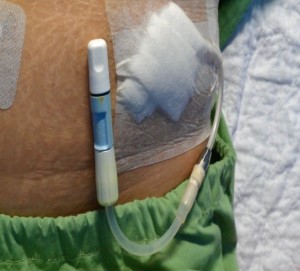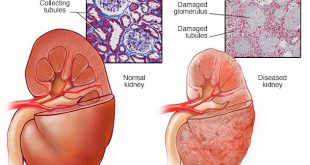Introduction
In patients with end-stage renal failure, the current treatment is essentially aimed at replacing the various functions of the failing kidneys. Hence the term “Renal Replacement Therapy” is appropriately used to cover all forms of treatment for end-stage renal failure. There are currently three treatment options available i.e
- Renal Transplantation
A functioning kidney from another individual is surgically transplanted into the patient and the new kidney will then take over the function of the patient’s failing kidneys. Renal transplantation is currently available in two Ministry of Health hospitals i.e. Hospital Kuala Lumpur (since 1975) and Hospital Selayang (since 2000).
- Peritoneal Dialysis
The patients’ abdominal peritoneum is used as the membrane to remove the waste products of the body and this is achieved by indwelling chemical fluid (dialysate) in the peritoneal space. Dialysate containing waste products are then replaced with fresh dialysate.
Peritoneal dialysis has the advantages of being home based, better tolerated by patients with heart disease and better preservation of the functions of the failing kidneys compared to haemodialysis.
- Haemodialysis
An artificial membrane (dialyzer) is used to remove the waste products from the patient’s blood. Patients’ blood is taken out, processed and then returned back to the patients by a haemodialysis machine.
Planning For Renal Replacement Therapy
It is extremely important that the planning for renal replacement therapy is done in a timely manner and should begin at least six months prior to the expected date of initiation of renal replacement therapy.
This pre-renal replacement therapy period is extremely important as it provides the time and opportunity for the patients to select the choice of their renal replacement therapy and to enable them to prepare themselves physically, mentally and financially for this lifelong treatment. The planning for renal replacement therapy will include:-
- Selecting the choice of the renal replacement therapy.
- Applying for financial assistances, supports and sponsorships for renal replacement therapy
- Undergoing clinical, laboratory and radiological evaluation together with the potential donor (if renal transplantation is available)
- Preparing for renal transplantation or dialysis access surgery
- Awaiting for dialysis access to be usable (if there is no viable renal transplantation option)
- Identify and applying for a place in a haemodialysis centre (if haemodialysis is the choice of therapy)
Early planning of renal replacement therapy will enable a smooth transition from predialysis to dialysis and will avoid the need for emergency dialysis which carries a high risk of complications and mortality. Timely initiation of renal replacement therapy could also prevent the occurrence of complications associated with end-stage renal failure.
Selecting The Choice Of Renal Replacement Therapy
The patients must be exposure to all three forms of renal replacement therapy and should be given adequate time to decide on their choice of renal replacement therapy. Adequate patient education and counselling are vital to enable patients to choose the appropriate mode of renal replacement therapy that best suit them. This is a daunting decision as it has a major impact not only on the patients themselves but to their family members, friends, colleagues, and employers.
It is not uncommon for patients to change their minds on their choice of renal replacement therapy as they learn more about the various modalities of renal replacement therapy and how these therapies affect their lifestyle. In some instances, patients may not be able to have the modality of choice due to medical reasons. Patients with severe heart disease may not able to tolerate haemodialysis while peritoneal dialysis may not be suitable for patients who had undergone multiple abdominal surgeries.
Patients may also start on one particular mode of renal replacement therapy and subsequently have to be converted to the other forms of renal replacement therapy due to medical, social or financial reasons.
Hence, patients may take weeks to months before deciding on the mode of renal replacement therapy.
- Selecting renal transplantation
Renal transplantation is the treatment of choice for end-stage renal failure as it provides better patient’s outcome and a superior quality of life1,2. However, it requires the availability of a functioning kidney from either a living or a deceased donor. Living related and spousal donors need to be evaluated extensively before the renal transplantation can be performed and this may take 3-6 months or longer.As preemptive renal transplantation (transplantation performed before the initiation of dialysis) has the best outcome and obviates the need dialysis access creation, it is important that discussion and planning for renal transplantation be done early3.
- Selecting peritoneal dialysisIf a patient prefers peritoneal dialysis as the mode of renal replacement therapy; early assessment of patient’s visual acuity, hand dexterity, home environment and workplace by the peritoneal dialysis team is important as this is a home based and self-care therapy. In patients who are unable to perform the peritoneal dialysis themselves, assisted peritoneal dialysis by family members may be considered.In order for the patient to perform peritoneal dialysis at home, peritoneal dialysis catheter needs to be inserted surgically into the peritoneal space (Fig 1 & 2). For the surgical wound to heal completely, the peritoneal catheter should only be used after 2 weeks3. Hence, the peritoneal dialysis (PD) catheter should be placed at least 2 weeks prior to the anticipated time of initiation of dialysis3.

Figure 1: Peritoneal Dialysis Catheter

Figure 2: Performing peritoneal dialysis exchange
- Selecting haemodialysisIf a patient chooses haemodialysis as the mode of renal replacement therapy, an arterio-venous fistula will need to be created (Fig 3). Early preservation of veins in the upper limbs is extremely important as these veins will be used for the surgery.Ideally, patients should have functional permanent vascular accesses at the time of haemodialysis initiation as this will avoid the need for the use of temporary haemodialysis catheters. A functioning arteriovenous fistula should be able to deliver adequate blood flow for haemodialysis treatment and must be easily cannulated3. The arteriovenous fistula should meet the following criteria to be considered functional 3:
- Access blood flow rate of at least 600 mls/min
- Depth less than 0.6 cm below the surface of the skin
- Minimal diameter of the arteriovenous access of 0.6cm
Maturation of an arteriovenous fistula usually requires at least 6 weeks but the time required for fistula maturation varies among patients3 It is not advisable to use the arteriovenous fistula within the first month after construction as premature cannulation of the fistula may result in haematoma and permanent loss of fistula3.
Hence, the arteriovenous fistula should be created at least 6 months prior to the anticipated start of haemodialysis2,3.This allows for access evaluation and provides additional time for revision of the arteriovenous fistula if it failed to mature3. As haemodialysis is a centre based treatment, patients will need to identify a suitable haemodialysis centre and will need to apply for a place in that unit. There are currently 3 main types of haemodialysis centre in this country i.e
- Ministry of health haemodialysis centres where the patients pay a nominal fee
- Private haemodialysis centres where the cost of treatment is completely borne by the patients or their sponsors
- NGO haemodialysis centres where the government subsidise around 50% of the treatment cost
Addresses and contact numbers of haemodialysis centres in this country are available in the National Renal Registry (NRR) and the Malaysian Society Nephrology (MSN) websites. Patients may use this website to look for haemodialysis centres that are situated near their home.

Figure 3 : Arteriovenous Fistula
Application for financial assistance, support or sponsorship for renal replacement therapy
There are various non-governmental organisations and religious organisations that may provide financial assistance for renal replacement therapy. However, this may differ from state to state and hence it is best to discuss this with your own nephrologist. Approval may take weeks to months and hence, patients should apply as soon as possible.
References
- Liem YS, Weimar W. Early Living-Donor Kidney Transplantation: A Review of the Associated Survival Benefit. Transplantation 2009; 87:317-318.
- Goldfarb-Rumyantzev A, Hurdle JF, Scandling J, et al. Duration of end-stage renal disease and kidney transplant outcome. Nephrol Dial Transplant 2005; 20:167.
- KDOQI Vascular Access Guidelines 2006
| Last Reviewed | : | 3 May 2016 |
| Writer | : | Dr. Esther Tan Zhao Zhi |
| Accreditor | : | Dr. Wong Hin Seng |
 PENDIDIKAN PESAKIT Kementerian Kesihatan Malaysia
PENDIDIKAN PESAKIT Kementerian Kesihatan Malaysia
